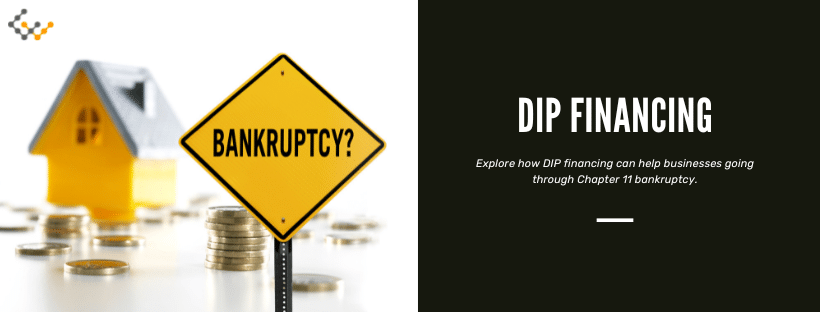What is DIP Financing and How it Works?

Securing financing is a process for any business that needs to borrow funds, but it’s especially challenging when going through bankruptcy. For businesses and firms that are facing bankruptcy, there’s debtor-in-possession financing (DIP financing).
What is DIP Financing?
DIP financing is a specific type of financing that may be available to businesses going through Chapter 11 bankruptcy proceedings. The term “debtor in possession” refers to a debtor’s remaining in control of the assets post-bankruptcy. Throughout and after the bankruptcy process, the debtor still maintains possession of their assets.
Thus, the purpose of DIP financing is to give debtors relief from creditors while retaining the debtor’s assets during restructuring. The debtor isn’t necessarily entirely insolvent but needs some time to restructure finances so that they can meet their remaining obligations after bankruptcy.
Answer a few questions and get custom mortgage quotes. We'll match you with offers from our network of 650+ lenders.
How Does DIP Financing Work?
Debtor in possession financing is executed under the supervision of a bankruptcy court. After filing for Chapter 11 financing, a business can access DIP financing for specific purposes. Essentially, the financing can be used to continue business operations. A business might pay employees, purchase goods, make payments on facilities, and meet any other ongoing financial obligations.
Court approval is required for any DIP financing agreement, and such loans come with a “superpriority” status. This means that repayment of the DIP loan takes precedence over any existing debt, equity, or other financial claims. From a lender’s perspective, DIP financing may be preferred if a business is struggling. Because the financing has superpriority status, lenders who underwrite DIP financing are more likely to be paid than any other party that the business owes.
Commercial Loans and DIP Financing
Debtor in possession differs from the many different types of commercial loans in several ways. Most obviously, DIP financing is only available during a Chapter 11 bankruptcy proceeding. Commercial loans generally aren’t available when undergoing bankruptcy, both because lenders don’t want to finance and the court must approve any loan.
As mentioned, DIP financing’s superpriority status ensures that it’s repaid before any standard commercial loans are. The status supersedes both primary and secondary mortgages on commercial real estate properties, as well as any other debt a business might have. The status also means that DIP financing is paid before investor distributions are made, real estate equity is paid out, or any other profitable payment.
Because of the high-risk nature that comes with offering financing to distressed businesses, DIP financing typically has higher interest rates and much less favorable terms than commercial loans do. Even the least attractive commercial real estate loans or worst unsecured business loans are likely to have better terms than DIP financing will give. Thus, DIP financing should be a last resort that businesses only pursue when bankruptcy is imminent.
Benefits and Risks of Debtor in Possession Financing
As with any financing, debtor-in-possession financing has both benefits and risks associated with it.
Benefits of Debtor in Possession Financing
- Immediate Liquidity: DIP financing allows for an instant cash influx, allowing the business to maintain operations during the bankruptcy restructuring.
- Financial Stability: By offering a reliable source of funds, DIP financing ensures financial stability during bankruptcy proceedings.
- Confidence Boost: The assurance of financial support can help to restore and boost stakeholder confidence during bankruptcy.
Risks of Debtor in Possession Financing
- Increased Financial Burden: Due to the high-risk nature of DIP financing, the interest rates are often higher than traditional loans that a business already has. This can add to a business’s financial burden, although any interest-caused strain is usually outweighed by the relief that restructuring offers.
- Limited Flexibility: Lenders may impose stringent conditions that limit a business’s operational and financial flexibility. Businesses aren’t in a position to negotiate or shop around.
- Deterrence to Unsecured Creditors: The superpriority status of DIP loans might deter unsecured creditors since it diminishes their chances of debt recovery.
How to Obtain DIP Financing: 5 Steps
1. Initiate Bankruptcy: Initiate Chapter 11 bankruptcy, as this is a prerequisite for obtaining DIP financing. The proceedings will let your business continue operations under the court’s supervision while you negotiate with creditors about debt repayment.
2. Formulate Recovery Strategy: The bankruptcy proceedings will require a comprehensive recovery strategy. Your recovery strategy should clearly illustrate the way in which your company intends to regain its profitability, so it can meet financial obligations in the future. DIP financing is to serve as a means of executing this strategy.
3. Identify a Lender: You’ll have to identify a lender who agrees to the recovery strategy. Commercial or investment banks might underwrite a loan, or a private fund could in select situations. Keep in mind that the superpriority status and your business’s weak position can be attractive to lenders.
4. Negotiate Loan Terms: Loan terms will have to be established with the selected lender. Interest rates, repayment schedules, and possible covenants or conditions set by the lender must be established. Given the high risk and weak position, don’t expect favorable terms.
5. Secure Court Approval: The final step is to obtain approval from the bankruptcy court for your DIP loan. The court will meticulously inspect the loan terms to confirm that they are equitable and in the best interest of all stakeholders.
DIP Financing vs Other Financing
Unlike other forms of financing, DIP financing is uniquely designed for financially distressed businesses and firms that are under bankruptcy protection. DIP financing is often the only form of financing when in a Chapter 11 bankruptcy, making it the necessary choice during a tough situation.
When to Apply for DIP Financing?
DIP financing is generally reserved only when a company’s financial situation has deteriorated to the point of needing bankruptcy protection. When there’s no realistic way to restructure and turn around a business outside of bankruptcy, DIP financing might be used during Chapter 11. Businesses apply only after filing for Chapter 11 bankruptcy.
Wrapping Up
DIP financing can enable businesses to continue operations while restructuring under Chapter 11 bankruptcy. If your business or firm is ever in this situation, DIP financing will likely be your only loan choice. It’s not ideal, but it’s there when no other option is available.

